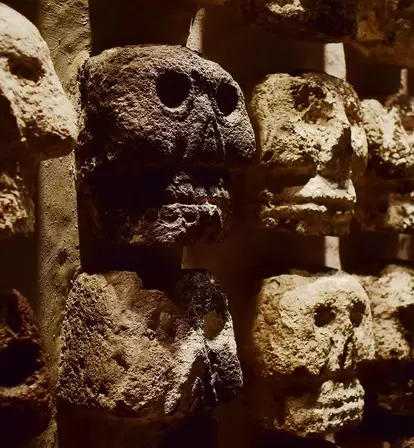Experts weren't sure whether to believe Hernán Cortés' reports of an Aztec temple with a wall featuring 130,000 human skulls — until a 2017 excavation revealed the chilling truth.
Beneath Mexico City lies what the Aztecs believed to be the center of the universe: Templo Mayor. It was obliterated by Spanish invaders in 1521 and has remained dormant beneath the bustling streets of the city above.
Only recently has the world begun to understand the hidden history of the Aztec’s “Main Temple,” where a wall with thousands of skulls was said to be buried. Historians used to believe this was mere anti-Aztec propoganda — until they made a startling discovery in 2017.
The First Glimpses Of Templo Mayor

Wikimedia CommonsThe ancient Templo Mayor stood at the heart of the Aztec city of Tenochtitlan.
In 1913, sunlight touched Templo Mayor for the first time in centuries when a Mexican archaeologist named Manuel Gamio, recently appointed Inspector of Ancient Monuments, discovered its southwest corner beneath a demolished house.
Gamio’s subsequent digs around the property revealed serpents made of stone. The property had belonged to the 16th-century Spanish conqueror, Alonso de Ávila, and historical texts had long claimed that Templo Mayor lay there too.
Like a coiled serpent, the mystery of Templo Mayor began to unravel as the decades went on.
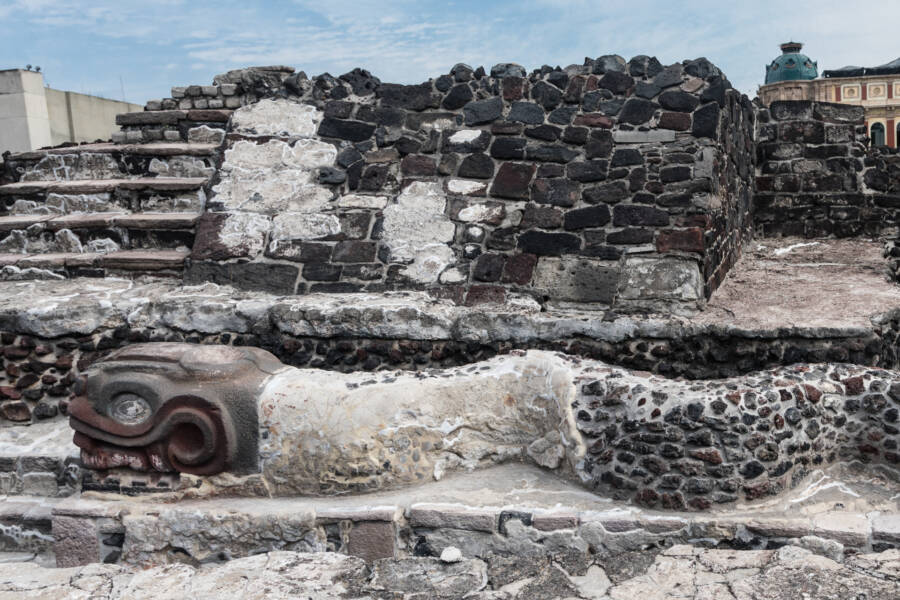
FlickrA stone serpent at Templo Mayor in modern-day Mexico City.
First, a staircase was found in 1933; then more stone serpents in 1948; and in the 1960s, the extension of Mexico City’s subway led to a treasure trove of Aztec artifacts.
Still, the grand Aztec temple in its entirety remained elusive. Bits and pieces had come to light, but how much more could be uncovered? Spanish conquerors had described massive pyramids and walls packed with human skulls. Could such a thing exist? Or had the Spanish, in their feverish destruction of Aztec society, razed Templo Mayor completely?
Finally, in 1978, the world drew closer to the answer. A ditch-digger reached down to wipe the soil from an enormous stone that was 10 feet in diameter and which blocked his progress. As the dirt of the ages fell away, he found himself staring at a carving of a woman. She was dismembered and decapitated.
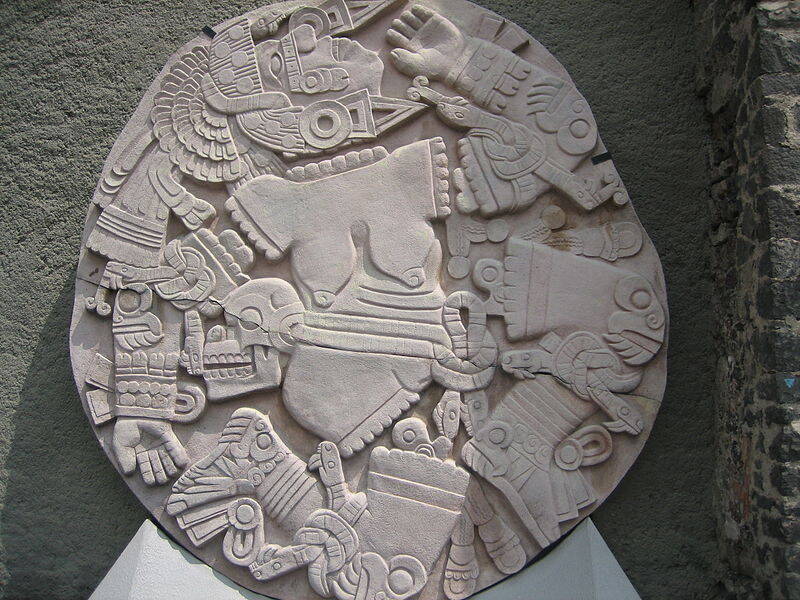
Wikimedia CommonsCoyolxauhqui, the Aztec goddess of the moon.
The woman was not really a woman at all. She was the Aztec moon goddess, Coyolxāuhqui (pronounced “coy-ol-shau-key”). According to Aztec myth, her severed head was the moon itself. Aztec legend claimed that Coyolxāuhqui plotted against her mother, only to be killed by her brother, Huītzilōpōchtli (“wit-si-lo-poch-tli”), the Aztec god of sun and war — and one of the deities honored at Templo Mayor.
Then, in 2017, another structure was discovered at Templo Mayor: a wall comprised of more than 600 skulls. The lives lost in service to the creation of this wall would create a grisly complication in the scholarship of Aztec sacrifices.
The Human Sacrifices At Templo Mayor
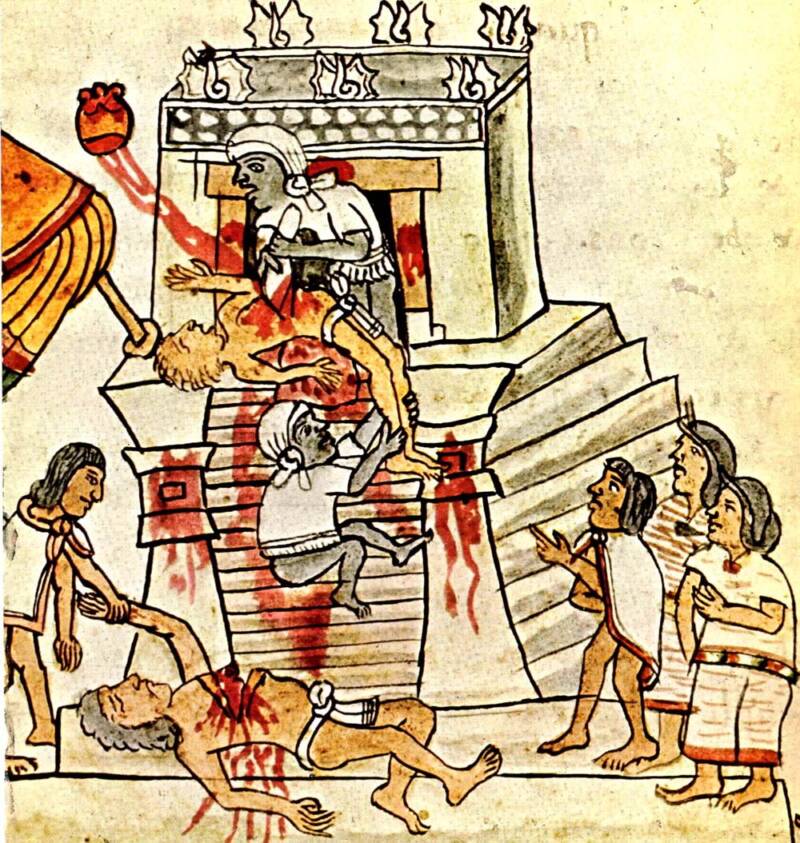
Wikimedia CommonsThe Aztecs sacrificed humans to appease the sun god.
The Aztecs considered Templo Mayor, or the “Main Temple,” to be the center of the universe. It was a central gathering place in Aztec life within the city of Tenochtitlan, the capital of the once-thriving and sophisticated empire, and was thus also the center of religious life.
Construction of the temple began in 1325, around the same time as the founding of the grand Aztec capital, and over the next 200 years, Templo Mayor would undergo multiple reconstructions, enlargements, and revisions. Although the form of the temple constantly changed, and was rebuilt seven times before Cortés’s arrival, the location remained fixed because it was believed moving the site of the temple would invoke the wrath of the gods.
As the center of religious life, Templo Mayor played an important role in human ritual sacrifices.
During a ritual sacrifice, prisoners were painted and dressed in bright colors. As crowds gathered, the victims were dragged up the grand steps of the temple and to the peak of its pyramids.
There, the Aztecs would stretch a victim across a sacrificial stone. As crowds below watched, a priest would raise his hands, the sunlight glinting against the obsidian knife he held in his fists. In a flash, he’d plunge the knife into the chest of the victim and wrench out the victim’s still-beating heart from their chest.
Sometimes women sacrifices were decapitated and dismembered in imitation of the Coyolxāuhqui myth. The priest would hold the heart to the sky for Huītzilōpōchtli, the sun god, to see, and then smash it against the sacrificial stone. Then, priests would cast the body of the victim down the steps of Templo Mayor.
The victim’s body would then be moved to another chamber. There, priests used obsidian blades sharper than present-day surgical steel to slice into the vertebrae of the neck to decapitate the victim. Then, they removed the skin and muscles, and the priests drilled holes on either side of the cranium.
Finally, the skull could be fitted onto one of Templo Mayor’s giant skulls racks, called “tzompantli.” Some would remain here; others, after months or years of weathering the elements, would be turned into masks.
The form of Aztec sacrifices often varied. At the opening ceremony of the sixth Templo Mayor in 1487, some 4,000 people were sacrificed over four days. On any given year, the Aztecs sacrificed thousands — some estimate that the Aztecs sacrificed up to 20,000 in a year — in their determination to appease the gods.

Wikimedia CommonsThis map of Tenochtitlan was printed in 1524, just a few years after Cortés conquered the city.
Believing they owed a debt to the gods, the sacrifices were meant to appease and satisfy the deities that controlled the weather, the bounty of crops, and the happiness of the civilization. Without human sacrifice, the Aztecs believed, the sun might not rise. The world itself could crumble into dust.
The intense violence of the sacrifices, then, served an important and positive purpose to the Aztecs. They were considered vital, life-giving, and nourishing. Botanical remains found on the skulls at Templo Mayor suggest that they were decorated with flowers, indicating that the Aztecs viewed the sacrifices as more than violent, and perhaps even as something beautiful and graceful.
At Templo Mayor, archeologists have determined that although many of the skulls belonged to men likely of warrior age but the tower uncovered in 2017 contained a surprisingly high percentage of skulls from women and children. The women and children might have been captured alongside warriors, then sold as slaves to be sacrificed. Many Spanish accounts claimed as such.
However, archeologists studying the teeth of several victims determined that many of those killed spent significant time in Tenochtitlan — slave or not, they had been absorbed into life in the Aztec holy city. As it turned out, they were not all captured, sold, and immediately sacrificed to the gods.
The Spanish Arrival In Tenochtitlan
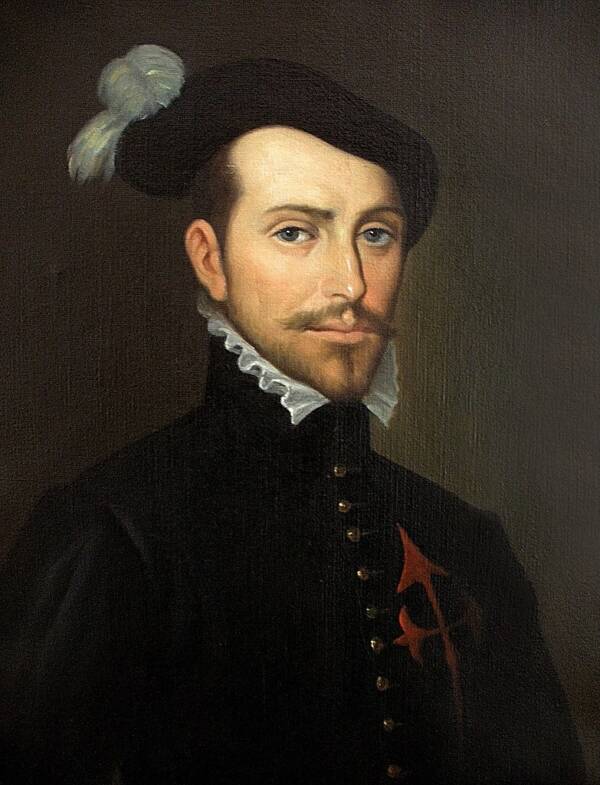
Wikimedia CommonsSpanish conquistador Hernán Cortés arrived in the New World when he was 18. Less than two decades later, he razed the Templo Mayor and the city of Tenochtitlan.
When Hernán Cortés arrived in Tenochtitlan around 1519, he would have noticed Templo Mayor right away. In the center of the city, which had about 80 buildings, Templo Mayor loomed the largest.
The grand temple was constructed of twin pyramids and stood 90 feet high. One pyramid represented Tlāloc, the Aztec god of rain; the other honored Huītzilōpōchtli, the god of sun and war. Shrines stood on the peak of both pyramids, which could be accessed by sweeping stone staircases. At the base of the pyramid, stone serpents stood guard. A third, lower temple represented the ancient serpent god Quetzalcoatl.
The city of Tenochtitlan equally impressed the Spanish. It contained 250,000 people, more than any European city of the era.
In a letter to the Spanish king, Charles I, Cortés described the Aztec capital:
“The city is as big as Seville or Cordoba. The main streets are very wide and very straight… sixty thousand people come each day to buy and sell.”
One of Cortés’s men, conquistador Bernal Díaz del Castillo, wrote that, “these great towns and [temples] and buildings rising from the water, all made of stone, seemed like an enchanted vision… Indeed, some of our soldiers asked whether it was not all a dream.”
The Destruction Of Tenochtitlan
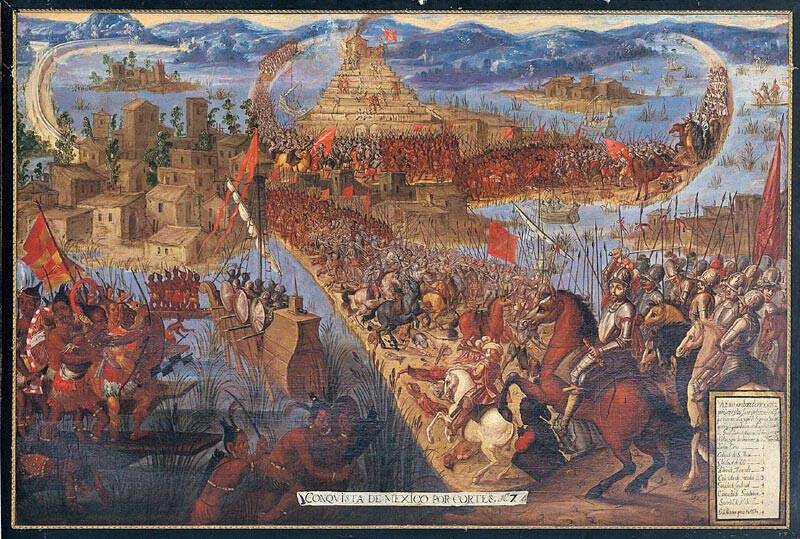
Wikimedia CommonsTwo years after Cortés landed on the coast of Mexico with an army of soldiers, he completely destroyed Tenochtitlan.
In 1521, Cortés lay waste to Tenochtitlan. The Spaniard had a significant advantage over the Aztecs, who, at first, took him to be the god Quetzalcoatl.
To the Aztecs, Cortés may have seemed to possess godly might. He brought with him smallpox, which decimated the indigenous people. He brought guns, which meant his troops could easily overpower the Aztec warriors. Cortés also had the luxury of a Mayan liaison, known as La Malinche, who could interpret Aztec plans and actions for him.
Cortés was ruthless and merciless. Upon hearing of an uprising among Aztec religious leaders, his second-in-command trapped them in a temple during a religious ceremony and sent in soldiers to massacre them.
No amount of ritual sacrifice could stop Cortés, and the Spaniard ended the world as the Aztecs knew it.
Spanish soldiers viciously destroyed Templo Mayor and the city of Tenochtitlan. One Spanish chronicler noted that “all the wonders” of Tenochtitlan “were overthrown and lost, nothing left standing.”
Other Spaniards described the Aztec capital in more nightmarish terms. In particular, they described the horrifying sight within a temple: a chamber filled wall to ceiling with human skulls.
It was believed that these macabre claims were perhaps just propaganda meant to justify the Spaniards’ destruction of the Aztec civilization — until the 2017 discovery proved them to be true.
Huey Tzompantli: The Wall Of Skulls
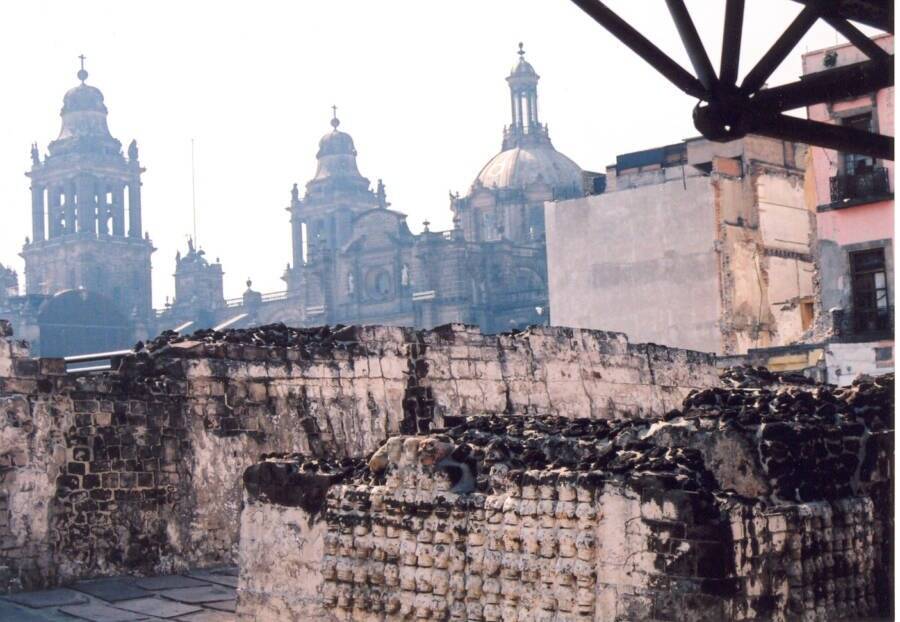
Templo Mayor MuseumThe Templo Mayor’s wall of skulls, or tzompantli.
The Spanish conquerors had described such a sight. A Spanish soldier named Andrés de Tapia claimed the rack held tens of thousands of skulls “placed on a very large theater made of lime and stone… many heads of the dead stuck in lime with the teeth facing outward.” Tapia calculated that the wall held 136,000 skulls, but this has long been considered an exaggeration.
Archeologists investigating the site of Templo Mayor in 2017 discovered a rack of almost 700 human skulls, most of them women and children. It has been dubbed “Huey Tzompantli,” which loosely translates to “The Great Wall of Skulls.”
“We were expecting just men… as warriors would be,” noted Rodrigo Bolanos, a biological anthropologist involved in the unearthing of Templo Mayor. “This is really new.”
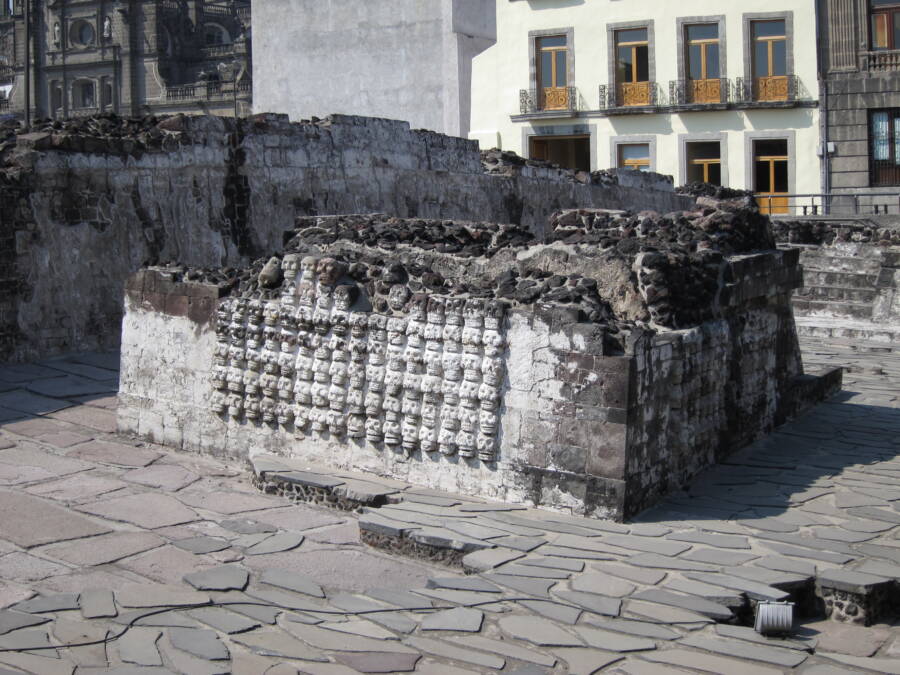
FlickrThe Spanish estimated that the wall of skulls they came across in the 16th century featured 130,000 severed heads. It was actually closer to 700.
The skulls were not attached to bodies or left in a pile. Each had a large hole on either side of the cranium where it was strung like a bead onto a thick wooden pole, creating a literal wall of staring, empty sockets, and dirt-sullied pale bone.
It is believed that the skull rack served three purposes and could be found in most Aztec cities. For one, it created a public display of human sacrifices. Two, it honored Huītzilōpōchtli. And three, the tzompantli invoked a powerful reminder of the Aztec empire’s reach and might.
Templo Mayor Today

Wikimedia CommonsToday, one can visit a Templo Mayor museum beside Mexico City’s Metropolitan Cathedral.
Over the ruins of the grand Aztec capital, the Spanish built their own city. And yet, Ciudad de Mexico, Mexico City, contains echoes of its Aztec roots.
The Aztecs’ center of the universe became Centro Historico, or El Centro, the apex of public and religious life. Today, political dealings continue at Palacio Nacional. The Spanish cathedral looms, just as Templo Mayor once did, over the city’s public square. The Spanish, in building their cathedral, even used stones from the smoldering remains of Templo Mayor itself.
The Metropolitan Cathedral was built on top of Templo Mayor to signify the conquest of the Spanish, but more and more of the Aztecs’ history is coming to light. Archeological investigations continue and visitors can wander through the Templo Mayor Museum. They can see Aztec artifacts: stone statues, obsidian knives, and the skulls of sacrificial victims.
And in the end, it may be the Aztecs who get the last laugh. The city of Tenochtitlan was built on a bog and as the years pass, Mexico City has begun to sink. Templo Mayor, however, was built upon a steady patch of landfill and is sinking at a much slower rate. Other structures descend into the earth at a rate of about 20 feet per century, but Templo Mayor remains more still.
As the rest of the city drops around it, Templo Mayor will rise.
Next, read about the discovery of grisly child sacrifices in Peru. Then, check out how the ancient Chinese sacrificed puppies instead of humans.
